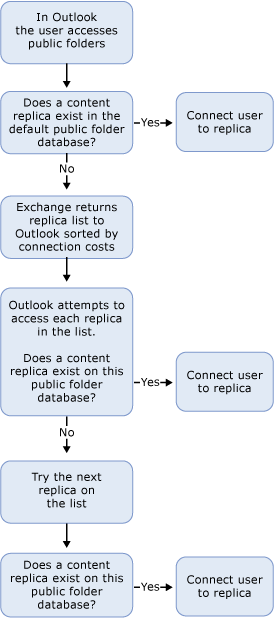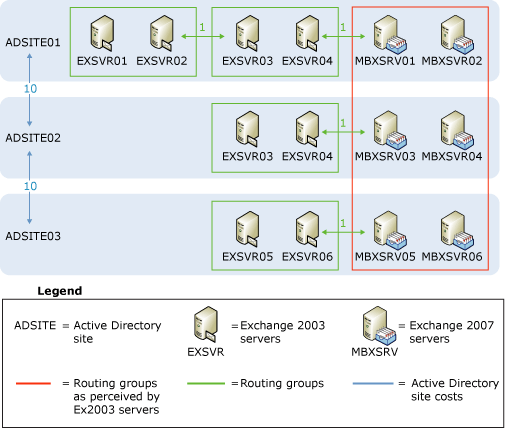Applies to: Exchange Server 2007 SP3, Exchange Server
2007 SP2, Exchange Server 2007 SP1, Exchange Server 2007
Topic Last Modified: 2007-10-22
When a user accesses a public folder by using a MAPI client application, such as Outlook, the public folder database determines which public folder replica the client should access. This process is called referral. If a replica of the requested content exists on the Exchange server that serves the client request, the client accesses the local replica. When a user connects to a public folder database that does not contain a copy of the public folder content that the user wants, the user is redirected to another public folder database that has a copy of the content. As illustrated in the following figure, you can create a custom cost list for public folder referral to control this redirect traffic.
 Note: Note: |
|---|
| Public folder referrals have an associated cost number. The numbers range from 1 to 100. This cost number is used to optimize message flow. Specifically, e-mail messages are routed according to lowest cost number. If two or more routes are available with the same cost, the load is distributed as equally as possible between them. This cost is also used to calculate the most appropriate route that the client application can use to access public folders on remote servers. |
Using the default referral configuration, Exchange 2007 follows the structure of your organization's Active Directory site to locate an appropriate server. However, to modify the flow of user traffic, Active Directory site administrators can redirect this configuration by specifying whether to allow referrals over certain connectors. For Exchange 2007 servers, you can also specify a list of referral servers and assign routing costs to each server to redirect server traffic. For example, you can limit referrals to a single Active Directory site or only allow referrals between certain servers in each Active Directory site.
 How Referrals are
Determined
How Referrals are
Determined
When a user connects to Exchange and uses a MAPI client application to request access to a public folder, Exchange locates a content replica of the public folder by using information supplied by the public folder database that is associated with the user's mailbox database. The public folder database retrieves the replica list of the requested folder and, if necessary, retrieves routing and cost information from Active Directory Sites and Services. Exchange uses the following process to locate a content replica:

- The MAPI client connects to the user’s mailbox database to
access the user's private folders. The MAPI client also connects to
the user's mailbox to retrieve the default public folder database
for information about the public folder hierarchy. For more
information about how to set the default public folder database,
see How to
Change the Default Public Folder Database for a Mailbox
Database.
- The MAPI client attempts to read the content for a specific
public folder. Initially, the default public folder database is
queried for the content. If that database is a content replica for
the folder in question, the process is complete.
- If there is no replica on the default public folder database,
Exchange returns a list of replicas to the client, sorted by that
server’s perspective of connection costs to each of the other
listed content replicas. Connection costs are determined by
querying Active Directory Sites and Services for the site connector
cost information of the other Mailbox servers in the organization
on which a public folder database resides. Alternatively, you can
specify costs to other servers by providing a custom override list
to the public folder database. The list that is returned to the
client does not include servers for which the cost is greater than
500.
 Note:
Note:Cost information is refreshed once every hour. Therefore, any changes to Active Directory site costs are not available for up to one hour. In addition, any changes in the public folder custom list, including its initial configuration or complete removal, is not available for up to one hour. Servers that are not listed in the custom list of the public folder will never receive referrals from the server that has the custom list. - The MAPI clients attempt to access each replica in the list by
connecting to the server, attempting to locate the folder, and then
attempting to read the folder's content.
- If a failure occurs, the client attempts to access the next
replica server in the list until the client has attempted to access
all replica servers in the custom list.
 Note:
Note:The MAPI client does not refresh its connection unless its current connection is terminated. In other words, if a preferred or low-cost replica cannot be reached, the client attempts to access the next replica in the list, which may be very expensive to reach. If the low-cost server becomes available, the MAPI client does not redirect the connection to the low-cost replica until the user logs off from and the logs back into the MAPI client.
 Assigning Cost
Assigning Cost
Although Exchange administrators can create public folder referrals and site costs, we do not recommend that you do this because the maximum public folder referral cost that Exchange administrators can set for a public folder database is 100. By setting the maximum referral cost for a server to 100, the server may still be used for referrals.
Instead, public folder referrals and site costs should be determined by an administrator who is a member of the Domain Admins group or the Enterprise Admins group in Active Directory. In Active Directory Sites and Services, a user who has Domain Admin or Enterprise Admin permissions can set the public folder referral cost up to 500.This higher cost number helps ensure that a server will not be used for referrals.
For more information about the Active Directory sites in Windows Server 2003, see Sites Overview. For more information about how to configure site link costs in Windows Server 2003, see Configure site link cost. For information about the sites and services in Active Directory Domain Services (AD DS) for Windows Server 2008, see "Understanding Sites, Subnets, and Site Links" in Windows Server 2008 Help.
 Note: Note: |
|---|
| To create efficient public folder referrals, you must understand the structure of your organization's Active Directory site. For more information about routing, Active Directory sites, routing costs, and Send and Receive connectors, see Understanding Active Directory Site-Based Routing. |
For detailed steps about how to configure an Exchange 2007 server to use a specific list of servers and costs for referrals, see How to Configure Public Folder Referrals.
 Referrals in Mixed-Mode
Topologies
Referrals in Mixed-Mode
Topologies
If your organization is using a mixed mode topology with Exchange 2000 Server or Exchange Server 2003 public folders and Exchange 2007 public folders, we recommend that, for all mailbox databases, you set the default public folder database to be an Exchange 2007 public folder database. For detailed instructions about how to set the default public folder database in Exchange 2007, see How to Change the Default Public Folder Database for a Mailbox Database. For detailed instructions about how to set the default public folder database in Exchange 2003, see Linking Mailbox Stores and Public Folder Stores.
In a mixed mode topology, you can have replicas for public folders on Exchange 2000, Exchange 2003, and Exchange 2007 servers in the same organization. Exchange 2000 and Exchange 2003 use routing groups and routing group connectors to determine costs for public folder client referral to other servers. To compute the referral cost to each Exchange 2000 and Exchange 2003 server, Exchange 2007 uses the Active Directory Site Connector cost information, which is the same method used to compute the referral cost to each Exchange 2007 server.. However, Exchange 2000 and Exchange 2003 view all Exchange 2007 servers in all Active Directory sites as being members of one single routing group. Consequently, Exchange 2000 and Exchange 2003 servers perceive the public folder referral costs to all Exchange 2007 servers to be the same. As a result, client applications could be referred to servers over expensive network links instead of being referred to local servers.
As previously stated in "How Referrals are Determined" earlier in this topic, the default public folder database is queried first by the client application (such as Outlook). Then, if a referral is required, Exchange returns a list of replicas to the client, sorted by that server's perspective of connection costs to each of the other content replicas that are listed. Therefore, the server on which the default public folder database resides determines which replica server to use. If the default public folder database exists on an Exchange 2000 or Exchange 2003 server, any Exchange 2007 servers that are listed in the replicas are sorted together as having the same cost because Exchange 2000 or Exchange 2003 perceives them all to be in the same routing group.
The following figure helps illustrate this scenario.

In this scenario, the organization has three Active Directory sites: ADSite01, ADSite02, and ADSite03. An administrator who is a member of the Enterprise Admin or Domain admin group has set the referral cost for ADSite01 and ADSite02 to a cost of 10, ADSite02 and ADSite03 to a cost of 10, with a cumulative cost of 20 between ADSite01 and ADSite03. In addition, the administrator has set the routing costs for the various routing groups in the Active Directory sites to a value of 1. If the Exchange 2007 Mailbox server named MBXSRV05 that exists in ADSite03 contains the default public folder database, and MBXSRV05 returns the list of replicas to access, MBXSRV05 will correctly report that the Exchange 2003 server named EXSRV02 that exists in ADSite01 has a cost of 20. However, if EXSRV02 contains the default public folder database and EXSRV02 returns a list of replicas to access, EXSRV02 may report that MBXSRV05 has a cost of 1 because EXSRV02 views all Exchange 2007 servers as belonging to one routing group.
 For More Information
For More Information
To learn more about public folders, see Understanding Public Folders.
For more information about managing public folders, see the following topics:

